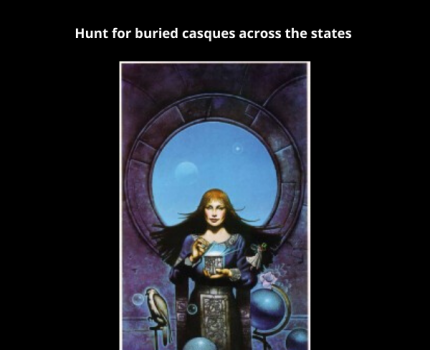
In 1982, The Secret: A Treasure Hunt by Byron Preiss was published. This launched an armchair treasure hunt which continues on today. After almost 40 years, nine of the twelve buried casques remain to be unearthed. Only three have been found. These three were found in Boston (2019), Cleveland (2004), and Chicago (1983).
The remaining casques, with keys to claim a valuable gemstone, are most commonly believed to be buried yet in New York, Roanoke, Charleston, St. Augustine, New Orleans, Houston, San Francisco, Milwaukee, and Montreal (Canada). Clues leading to the discovery of the casques are given by a matching Verse and Image. (more on those here)
While many of the clues are thought to be ‘solved’, the exact dig spots are elusive. It doesn’t help that many of the locations are in protected areas, where digging is prohibited, and that the passing of time has likely affected some of the final clue meanings. But this is a treasure hunt, after all. It isn’t supposed to be simple, or it wouldn’t be considered a treasure once found.
So we have to work with what we have. And we do have three found casques. What might we be able to learn from them? What clues gave their exact dig spots? Could they help find the others? Let’s explore!
Chicago Casque of The Secret (Found in 1983):
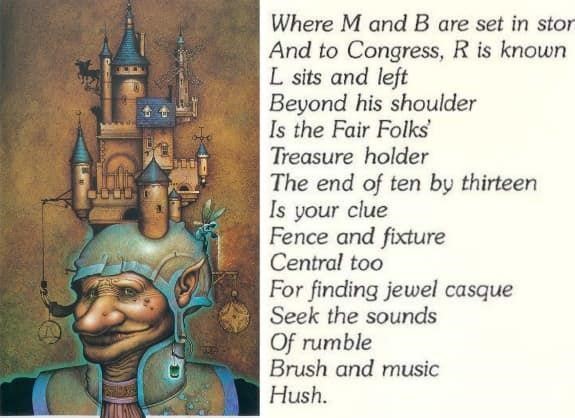
The following video explains the process in which took the finders, Eric Gasiorowski and Rob Wrobel to where the casque was buried.
It’s mentioned the tower with windmills in the image was first noticed to match the water tower in Chicago. The statue of the Bowman, matching the image, is located at the head of Congress Drive, with a statue of Lincoln nearby. These items led them to the matching verse where additional clues: Where M and B are set in stone (Mozart and Beethoven), And to Congress, R is known (Roosevelt University building near). These confirmed the general area. Now it was to find the exact spot.
The Verse continues:
L sits and left, Beyond his shoulder, Is the Fair Folks’, Treasure holder.
Over the left shoulder of the statue of Lincoln was found the matching ‘Fence’ in the image, leading closer to the treasure. The next lines of the verse are believed to be the clues for giving the exact spot to dig:
The end of ten by thirteen, Is your clue, Fence and fixture, Central too
The remaining lines of the verse confirmed the area more. They were:
For finding jewel casque, Seek the sounds, Of rumble, Brush and music, Hush
Rumble: near train tracks / Brush: Art Institute near / Music: Petrillo Band Shell near / Hush: The Secret
Where to dig? That is the question. In the video we hear Rob saying they dug many holes. Was there something in the verse or image that should have defined the exact location more?
The end of ten by thirteen are thought to be referring to trees. Fence and fixture, Central too seem to help define that spot more.
After so many years, it is difficult for the finders to remember ‘exactly’ where they dug. Was it at the end of the 10th tree? The central spot between the 10th and 13th tree? It’s thought there was a ‘fixture’ on the wall nearby, and the intersecting/central point from the Fence post to Fixture could have pinpointed the spot.
In 1983, when they found the treasure, and at the time as kids, it was the treasure and claiming of gemstone that mattered. Not the exact and precise location to record. The hunt was over. It didn’t matter. Until now, when trying to find others, and wondering, how was it ‘exactly found?’ Do we know?
There are theories, the warts in the image might have offered the final clues for the exact spot to dig.
And recently, Dustin and Deidra White offered a tantalizing theory that using a shadow, of a certain feature on location, at a time and date indicated for each paired image and verse, determines the exact spot to dig. For not only Chicago, but all of the Secret Locations. Is that why ‘Hush’ is at the end? Use the ‘Secret’? Use the The Shadow? (more on the Secret Theory here)
This theory was tested for Chicago. Rob Wrobel and friend went to Grant Park, and at 5 O’clock (time thought to be indicated for this casque, on May 21, looked for the shadow. The sun wasn’t very cooperative. But, the next day, the sun was more helpful. Using the Fence post as the feature to cast the shadow to pinpoint the location, a potential, and precise dig spot was given.
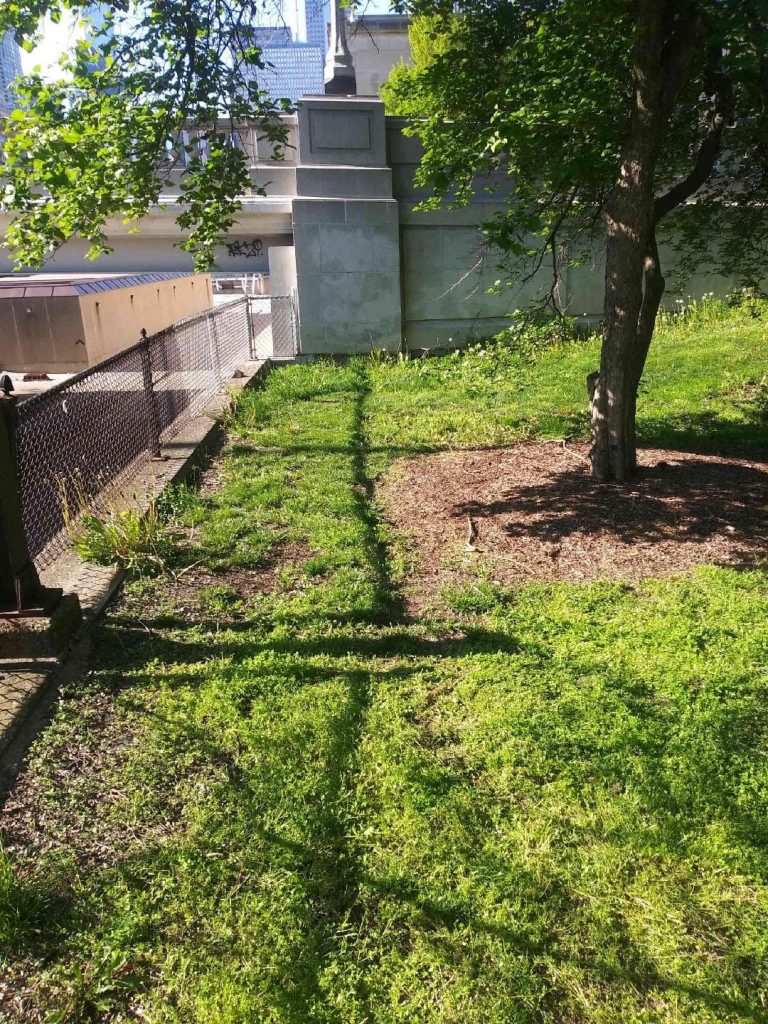
Was this the spot Rob and Eric dug at in 1983? As mentioned, the exact spot cannot be remembered precisely, but Rob thinks it was close, so the Shadow Theory is very much in play. It might be part of The Secret. Sure, it can’t be said it’s beyond any ‘shadow of doubt’, but more testing can be done.
This takes us to the Cleveland Casque of The Secret:
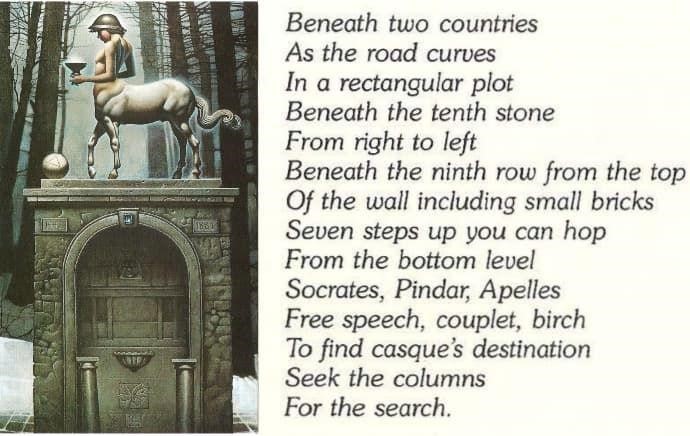
What were the clues for its exact dig spot? This casque was found in 2004 by Brian Zinn and Andy Abrams using Image 4 and Verse 4. I decided to ask them about their thoughts about the location.
- Question to Andy: Did you have any doubt you were at the right spot while digging for the Cleveland Casque? What were the most telling clues for exactly where to dig? And when looking at other verses, do you feel the clues for precisely where to dig are given?
Andy’s Answer: When we first got to the Greek Garden and saw the column and wall we were blown away and we knew that if a treasure HAD been buried, it was there. Before we walked to the wall, we walked to the nearby Italian Garden where we took in the arch and lion face fountain and we also walked past the cup that the Centaur is holding and again, these visuals gave us complete confidence that Byron had been to this location and taken photos that he had mailed to Palencar for inclusion in the image (little did we know that Palencar knew this area so well as this was the one treasure that JJP had helped Byron bury!!)
We made our way back to the wall in the Greek garden and we saw the names Socrates, Pindar and Apelles on the wall and it made our hearts beat faster. There was a large rectangular plot on the front side of the wall, but the land was flat all around and nowhere to jump up. And, as it turned out, we were not allowed to dig on that side of the wall, as there were chairs being set up for a wedding that day! So we walked around to the back side of the wall and it was here that we found the area that was sunken and had different levels and steps so that you could stand at the bottom and step up, including the final step that you had to hop to reach the large flower box that was filled with shrubbery.
It was rectangular in shape and we knew in an instant that if the treasure was there, it was going to be in that flower box. The urns that are referenced in the verse were no longer there. Had they been, it would have been one final visual confirmer. Counting out the stones as the verse detailed, from left to right and from top to bottom and we had a very specific spot to plant our shovel. We dug for hours to the very bottom and hit pay dirt and concrete, with no casque in sight.
Only then did we turn toward the street below (MLK boulevard that used to be Liberty (referenced by the bell in the image) and we saw how the road ran along the bottom of this garden and ran along to connect to the next garden (the aforementioned Italian garden) and as it was beneath two countries as the road curves, we shifted our perspective and counted left to right in the other direction and still came down the specific number of stones in the wall to the opposite side of the large flower box.
From there, it was literally three pokes with the metal prodder and we hit the lucite box. So the directions once followed properly were incredibly precise. The only thing missing was an actual “X” that marked the spot. But the instructions followed correctly led us right to exactly where we needed to be.
Thank you Andy! and I did ask Brian a slightly different question too….
- Question to Brian: The image/verse matching the Cleveland Casque seems to be a bit more descriptive for providing an exact spot to dig compared to the Chicago Casque, would you agree? (Even though, it still took time in sorting out and digging). Or how do you feel it compares to the Chicago Casque? In hindsight, do you feel the clues provided the precise spot to dig? How deep was the casque?
Brian’s Answer: Yes, the instructions for Cleveland are much more detailed than Chicago – too bad the instructions are backwards! Those who have examined the instructions still debate over whether the instructions are intentionally backwards, or if they are just a bit “tricky” because the instructions are correct if you are standing on the other side of the wall from where the casque is buried. In any event, the instructions are not straightforward, and when you are looking for a small casque, you can be very close and still not find it. The casque was not too deep, about 1.5 feet down.
Thanks Brian.
Not much to add with these accounts. The verse and image led them to the exact place to dig, once understood correctly.
More on their stories here: In Search Series: Brian Zinn and Andy Abrams
So what about the Boston Casque?
This casque was found in 2019. None of us know where the exact spot the casque was buried in Boston. The reason is because it was found during construction and renovations to the site of the casque: the baseball field. Huge thanks goes to Jason Krupat, though, for alerting the construction workers to look for pieces of the casque and contact him if any were noticed. It is concerning to think that if the construction workers hadn’t noticed the pieces in the mound of dirt taken from the baseball field, we wouldn’t have a casque to compare other finds with today. The Boston casque would have been lost for all time. Has this happened to others?
Fortunately, we do have this third find to compare past and potential future solutions to, even though the exact spot remains questioned. But can it be deduced, now knowing the general area?
So what do we know about the find? I realize there is a lot of debate on how to follow the clues to the baseball field. That is for another post. However, once there, which we know from the casque pieces discovery, we would be. What are the clues that tell a searcher exactly where to dig?
Here is the Verse and Image: What is there to define the dig spot?
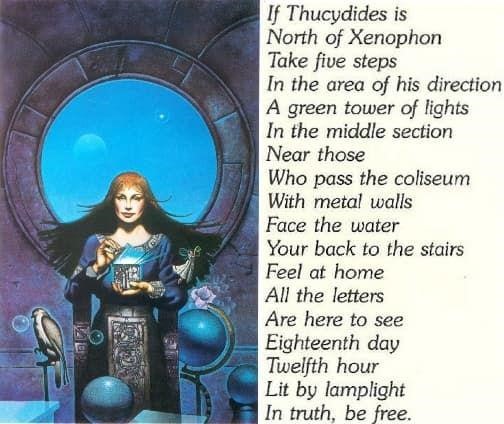
- I asked John Michaels (quite a while ago) this question: So where is it assumed the Boston Casque was exactly buried? Sure near Home Plate, but where there? Could it have been the line ‘Take Five Steps in his direction’? (from home plate) that provided an exact dig spot?
John’s Answer: As far as the final dig spot is concerned, that was my thinking exactly per the verse lines. One would think that it even might be 5 steps along the FIRST or THIRD base lines from home plate. Or perhaps toward the pitcher. I think that if one extrapolated all the answers for the T & X riddle in the beginning, perhaps that end part would make a bit more sense.
Anyone who has digested the book, and understands it as a puzzle is still going to have some questions. “A little digging” is what it says in the limited amount of instructions we are given. This implies that there is a method which lands you right on top of it. Then we have the birth month flowers, the birthstone and the extra numbers which haven’t been accounted for as well as the painting of the sun and a clock on the lid of the casque.
Talk about having leftover pieces, there’s a leftover puzzle here! It seems that too many things have been un-accounted for. It seems that many people made a decided left turn at Albuquerque and missed the road completely, and then somehow joined back up with it 5 miles before the end. I had to drop many theories, even my own, and start over when Boston was confirmed. I realized that something big was missed, and without being able to hop in a DMC 25 and go back to 1982, I don’t know if the real solutions will ever be found. Maybe some people in the future will get lucky though, like what happened in Boston.
And another Question:
- Can we assume from JJ Palencar’s appearance on Expedition Unknown with Josh Gates on the Boston episode, that although there was an outline of Home Plate in the image, nothing more was placed in the image to help determine the precise dig spot – No X marks the spot in the image? That those clues for an X must come from the verse?
John’s Answer: This is what I was getting at before. It seems like a lot has been missed. You see the progression of the painting on the lid going from blue skies on Rob’s 5 O’clock lid, to a burnt orange, dusk or nighttime scene on the Boston lid denoting a day and night. All this detail just for you to verify you have the correct month? Hand painting 12 different custom lids, each with a day or night setting, each with a character showing a facial expression over a clock showing the time, just for a verification that you were able to match a birthstone with a month? Obviously if that image is thematic, it ties the theme together, if not it’s a clue to the theme. This is why I take the time to look at something as wild as a shadow theory, because it answers a lot of those questions, and it’s not new to treasure hunting, Kit Williams wasn’t the first to use that technique.
Yes I believe we have obviously looked over something, I don’t know if it’s a technique like using a shadow to point out a spot on the ground on a certain month, or if it’s something else which he was trying to teach us in the book.
I don’t personally believe that John Palencar knows the dig spots. I believe he knows the city and park, and he knows (or at one time knew) of the things that Byron gave to him to insert into the image, but I think that only Byron knew the exact dig spots and I believe that Byron devised all kinds of puzzles based on John’s work along with his own prose to put them out there.
As someone who has made puzzles, almost anything can be interpreted as a clue, even things you’ve never dreamed of. I’m sure people are stumbling over things which weren’t intended to even be clues. The “S” which JJP pointed out to be the “S” in Boston I had matched to a building in Charlesgate which was directly across the street from another grouping of image matches. It turns out John was just making a stylized “S.” These kinds of general clues which add continuity to the puzzle and the city, also tend to throw people off, and I think it’s intentional. I think BP had one general method to solving these and if you stray just a little, ones curiosity tends to take over. Was it a mark of genius or a happy accident? In any case, the Boston find should have been a wake up call to everyone to go back and re-examine everything.
Thanks John
So can we conclude anything from these three found casques?
There is still debate on exactly where the Chicago and Boston casques were buried. But it does seem that there are enough clues in the Verse, if understood correctly (like the Cleveland Casque), to indicate a dig spot. As for the Cleveland Casque, it is know precisely where it was buried, and it was the Verse which defined and told a searcher exactly where to dig.
Some observations or questions still:
- In the image, is there always an exact match to something very close to the dig spot? Chicago- Fence and Fixture / Cleveland- The Columns / Boston- Home Plate
- With the general location known, from using both Image and Verse, is it the Verse only that provides the exact location to dig?
It seems in many of the verses, the dig spot is being mentioned not at the end, but before. This is interesting to me. While the image and verse do provide a location, it seems to do so, not so much in a step by step order, but by providing an overall picture of what is found near and around the dig site. At any time during the verse it seems the exact dig spot could be given– especially if the dig spot for the Boston Casque was determined by taking five steps. Not saying it was, but what if?
To me, it sometimes seems as if Byron stands at the spot he buried the casque and describe items around it, what brought him here, while weaving in clues for the exact spot to dig, instead of walking a searcher on a path to the dig spot and describing it that way.
I wanted to ask George Ward his thoughts about the three found casques.
- Can any summary on what we might take from these found casques be given?
Here is George’s answer: The two most important things we can learn from the three found casques are simplicity and similarity. Each of these puzzles worked basically the same way, the paintings took you to a general area, and the verse took you to a casque. They didn’t require complex triangulation, nothing needed to be graphed, there were no detailed map overlays.
Every clue in every painting was large, in your face, and in hindsight, obvious. The fence post in Chicago was obviously the fence post in the painting, the planter in Cleveland was obviously the planter in the painting. No one needed a magnifying glass to find clues, they were right there in front of us the whole time. It only took one person to see them differently.
Same with each verse. Each line was obviously describing something concrete on site. Feel at home is obviously home plate. M and B is right there on Orchestra Hall, carved in stone never to fade away. The solved verses have no rabbit holes to jump down, they don’t require you to make any grand connections to historical figures, then follow their path through the past.
You don’t need to study the philosophies of Socrates, Pindar, Apelles to solve Cleveland. In fact, the solved verses do not require you to open a book at all. They simply ask that you find the right area, and follow their very direct, but obscure instructions. If there is only one thing that people learn from the solved puzzles, I sincerely hope it’s this. Think simply, follow the verse, and be the one person who sees it all differently.
Thank you George.
I think I’ll leave it at that. There is a lot more to discuss on these found casques, and how they might help. We’ll look into more later!
Best of luck with all that you seek! Always Treasure the Adventure!

